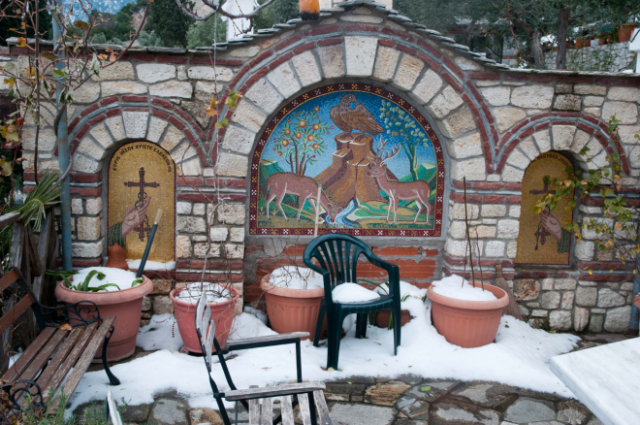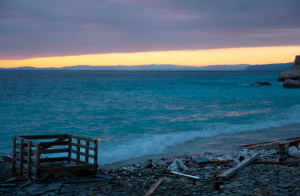The walk from Paulou to Nea Skiti is short. But the walk in Nea Skiti was long and confusing. Because we didn’t know where to go. Since Lewis Carroll we understand that: “If you don’t know where you’re going, any road will get you there”. So we were lost. We looked around for signs for the guesthouse. Near the church we saw doors with numbers, like a guesthouse, but de doors were all closed and there was nobody near that building. Later we were told that it’s the summer residence, beautifully situated just behind the church but without any heating, so closed during the winter.
 This skiti is like a rural village, small stone paved streets many with stairs. The roads are too narrow and too steep for cars. Mules only. There are quite a number of detached houses in the settlement, all dispersed and with gardens around them. Many with high stone walls. One house was completely destroyed by fire; only the walls and some blackened beams remained.
This skiti is like a rural village, small stone paved streets many with stairs. The roads are too narrow and too steep for cars. Mules only. There are quite a number of detached houses in the settlement, all dispersed and with gardens around them. Many with high stone walls. One house was completely destroyed by fire; only the walls and some blackened beams remained.
 Pilgrim Herman carefully going down the slippery stairs.
Pilgrim Herman carefully going down the slippery stairs.
In town there is one sign at a crossroad. To the left: the church, to the right: the harbour. A quintessential sign for the holy mountain; between church and harbour. The church here isn’t in the centre of the village. The village isn’t centred around the church. Quite different from the monasteries where the church is always in the centre and the rest of the monastery is built around it. Cold and windy it was, there was still some snow on the road. There were not many monks to be seen and even fewer we could ask for directions. One monk however named a father, whose name we immediately forgot, and pointed in a direction. That was it. We walked the road he pointed out. But after a few houses we were lost again. We didn’t know where to ask. We didn’t see anybody to ask. The weather wasn’t very inviting for outdoor activities.
 A view on the roofs of church and the bell tower.
A view on the roofs of church and the bell tower. Lots of places were still covered with plenty of snow, but most of it had been evaporated and blown of the trees. Finally we were able to see to the neighbouring Sithonia, the middle peninsula of the three fingers of Chalkidiki.
Lots of places were still covered with plenty of snow, but most of it had been evaporated and blown of the trees. Finally we were able to see to the neighbouring Sithonia, the middle peninsula of the three fingers of Chalkidiki. The abundant harvest of oranges was not collected at this deserted house.
The abundant harvest of oranges was not collected at this deserted house. After quite some time we found a young monk. He asked me friendly how many people were in our group and he wanted to know if we had already eaten. I told him that we hadn’t. He disappeared without saying a word. We waited on the terrace. One terrace below I discovered many bird cages. The monk had a fine collection of birds, which he imported from abroad. We have to come back to learn more about this man’s fascination. The idyllic picture in the middle, with the deer and eagle and the trees in full bloom is a mosaic. A very peaceful place to contemplate in different weather conditions and without cold feet.
After quite some time we found a young monk. He asked me friendly how many people were in our group and he wanted to know if we had already eaten. I told him that we hadn’t. He disappeared without saying a word. We waited on the terrace. One terrace below I discovered many bird cages. The monk had a fine collection of birds, which he imported from abroad. We have to come back to learn more about this man’s fascination. The idyllic picture in the middle, with the deer and eagle and the trees in full bloom is a mosaic. A very peaceful place to contemplate in different weather conditions and without cold feet.

A quarter of an hour later the monk with a long pony tail invited us in the kitchen for a meal. I saw an old monk sitting in the adjacent room. The young monk had prepared us a pea soup. There were olives and pickles, bread, that was meant to be dipped in to the soup, fresh cool water from an aluminium can and oranges as a dessert. The house had several orange and lemon trees all in full bloom in the terraced garden. The kitchen was well equipped but not well heated. We ate quiet, concentrated and fast. From left to right: the pilgrims Nathan, Herman, Laurens and Martijn, who all ate like wild boar. 
 After dinner I took a look at the pier where a boat would take us to a different world the next day. If there would be a boat. The first day of our trip there was no boat because of the waves. And the weather was changing again.
After dinner I took a look at the pier where a boat would take us to a different world the next day. If there would be a boat. The first day of our trip there was no boat because of the waves. And the weather was changing again.
Bas Kamps
